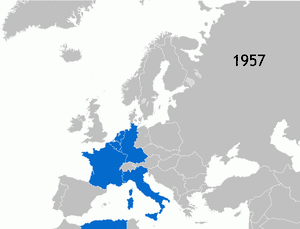Withdrawal of Greenland from the European Communities

The withdrawal of Greenland from the European Communities took place in 1985. This followed a referendum in 1982 in which 53% voted to leave.[1]
Greenland Treaty
| Treaty amending, with regard to Greenland, the Treaties establishing the European Communities | |
|---|---|
| Signed | 13 March 1984 |
| Location | Brussels |
| Effective | 1 January 1985 |
| Signatories | 10 |
| Depositary | Government of the Italian Republic |
| Languages | All 8 official Languages of the European Communities |
|
| |
The Greenland Treaty was an agreement between the member states of the European Communities, concerning Greenland's exit from the European Communities. It followed the Greenlandic referendum in 1982 in which voters supported exiting the EC.
The Treaty arranged for the exit of Greenland and amended earlier treaties of the European Communities. As such, it is an integral part of the constitutional basis of the European Union. The decision to withdraw was made after Greenland had achieved self-rule, was made to protect Greenland's rights to its fishing waters and to limit external influence.[2][3]
The Treaty entered into force on 1 January 1985, and on 1 February 1985, Greenland formally withdrew from the European Communities.
See also
References
- ↑ Jørn Boye Nielsen (2014), Bernard Cook, ed., Europe Since 1945: An Encyclopedia, Routledge, p. 541, ISBN 9781135179328
- ↑ "The Greenland Treaty of 1985". Web.archive.org. Archived from the original on 2014-04-16. Retrieved 2016-06-24.
- ↑ "Official Journal of the European Communities : Treaty Date=1985". Eu.nanoq.gl. Retrieved 2016-06-25.
Further reading
- Harhoff, Frederik (1983), "Greenland's Withdrawal from the European Communities", Common Market Law Review, 20 (1): 13–33
